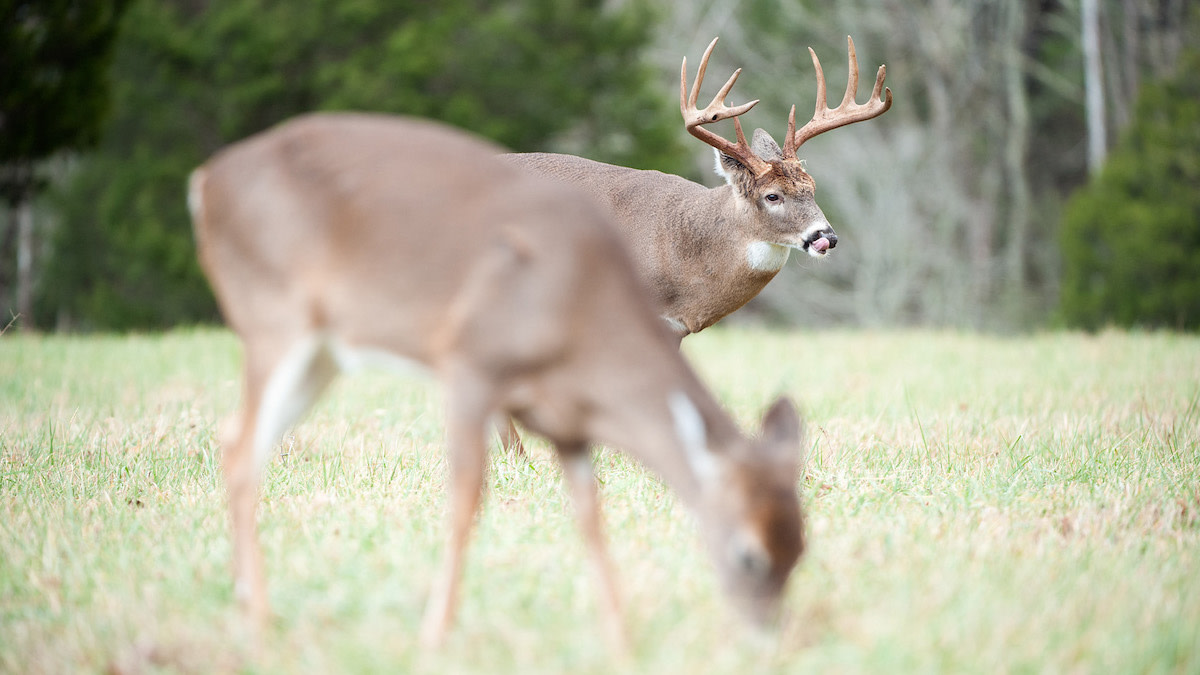
Deer decoys aren’t just for the Midwest. You don’t have to be immersed in agriculture fields or extensive, well-manicured food plots (but they can certainly help). From my experience, pinpointing your local peak breeding window and exactly where does will be in late October and early November are key factors.
I’ve always believed the best decoy is a doe, and I’ve killed many good bucks using that style. Why mimic a doe in heat? Well, consider what a buck is really looking for—a hot doe or a rival buck. You catch more flies with honey, and you’re more likely to entice a jacked-up, testosterone-fueled bruiser with a doe ready to breed.
When the first does hit estrous cycles, the time is ripe to implement this method. Proper timing is imperative to capitalize on bucks hunting female companions.
The estrous scent is unmistakable in the whitetail woods. Usually, in my area of South Carolina, it fires up the third week of October. At this point, bucks are up and running around with one goal in mind. Don’t wait for bucks to randomly walk in front of your stand. Instead, use a decoy and you may be pleasantly surprised what appears coming in on a string, as the old timers say.
Through scouting and herd intel, you can lure a buck of any age class within bow range—even within heavy hunter-density areas. But it’s not an every-hunt tactic to run; only decoy when conditions are right and the wind is in your favor. I may only hunt with a doe decoy once a year and have gone a couple of seasons without using it. It’s certainly not suitable for extremely tight areas.
How to Have Success Using a Doe Decoy
Scouting does is crucial during the rut. Hunt does in order to kill bucks. If you find does during the breeding season, you’ll find bucks. You are hunting bucks, but they are hunting does. Know where does bed and where they travel to feed. You must have a grasp on where female deer will be to pursue bucks during the rut.
I don’t target buck bedding areas. Bucks are highly unpredictable where they bed during the rut. They travel throughout the day and will bed down anywhere possible.
Ideal Locations for Doe Decoys
Food plots and agriculture fields are my go-to plan when a big-antlered whitetail is in the immediate area yet reluctant to step out amid legal shooting hours. Once bucks commence their pursuit of hot does, it can be rather challenging to obtain a clear shot on their vitals. This is exactly why I chose a decoy to stop a buck for just enough time to squeeze the trigger.
Other great locations to set up a doe decoy include clear-cut sites within close proximity to bedding; thinned, burned, and open pine blocks; and bottomland hardwood sites. Ideally, these should be adjacent to thick, impenetrable cover or even a staging area. Consider doe bedding areas or where they’ll travel to destination feed sites.
I find it best to give whitetails a buffer of at least 75 yards before they lay eyes on the decoy. You don’t want to startle an ungulate prey species that has evolved over millions of years. Especially a cunning, highly alert matriarch doe. It’s important in these situations to play the wind smartly and don’t spook the does.
That being said, I’ve never had a doe become alarmed from my decoy which has always surprised me. However, I’ve never set up in tight confines. They usually look briefly, but that’s about it. Why? Because female deer are generally more comfortable around other female deer. Bucks tend to worry does around the rut when they aren’t receptive yet. That’s another reason why I run a female decoy set and not a young or old buck.
Killer Scenarios for Doe Decoys
This tactic is especially useful if a buck has cruised past over the course of several hunts and you’ve been unable to get a shot off, or if he hangs back in a staging area until dark.
If you find a doe food source that’s loaded with fresh buck sign (scrapes, tracks, and rubs), it’s a prime location for a mature whitetail to pop out. If a buck doesn’t show, you will eventually put too much pressure on the stand, and does will shift. Get aggressive and lure a shooter in.
Doe Decoy Setup
First position the decoy on the opposite side of where you think a buck will enter your field of vision. Don’t place the decoy close to your stand unless you’re bow hunting. You don’t want deer possibly catching your movement or coming out on top of you. Typically, I attract several young bucks for every decent-sized 3.5-year-old.
I recommend using scent where legal. I prefer estrous scent in reusable cans. Use the wind to your advantage and position the scent to drift where a buck should appear. CWD-friendly, synthetic estrous is now available to purchase.
Bleat calls can be effective but don’t overuse them. A little goes a long way and altering the duration and sound is killer for natural authenticity. Grunt calls can also be good to entice a buck within earshot to check out the scene.
Lastly, always be safe when transporting and setting up deer decoys. It is imperative to wear hunter safety orange and never assume anything with other hunters—even while on private land. Be sure to check the local game laws before using a decoy and scent.
Feature image via Matt Hansen.








Conversation